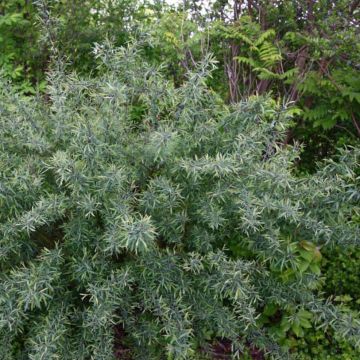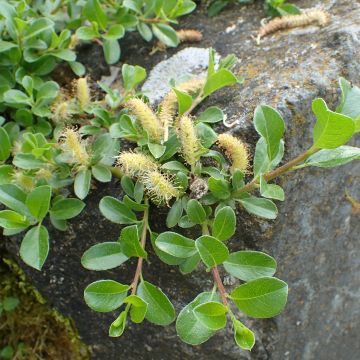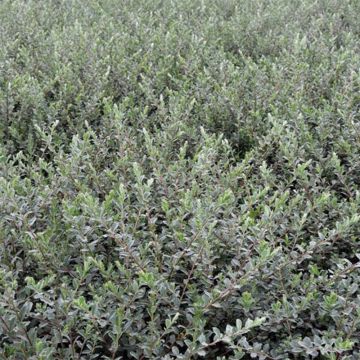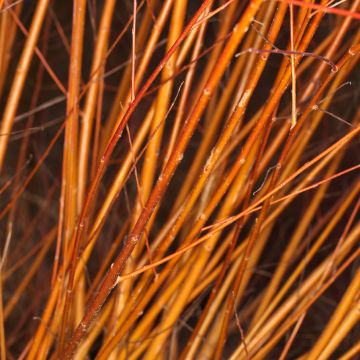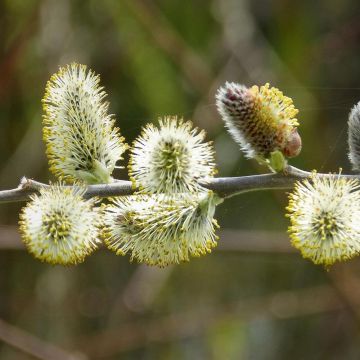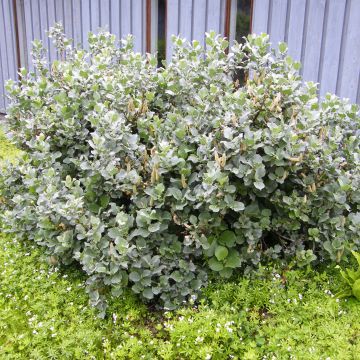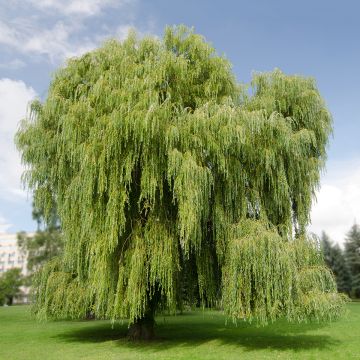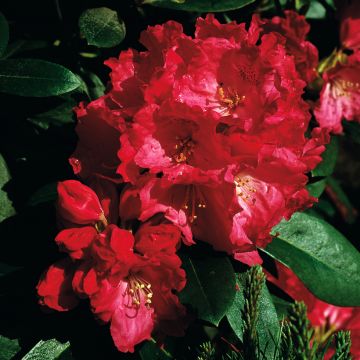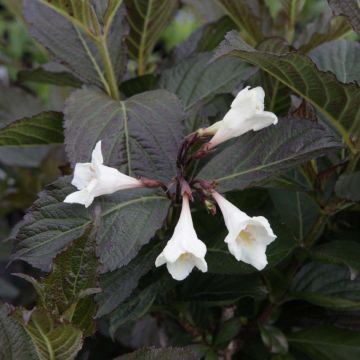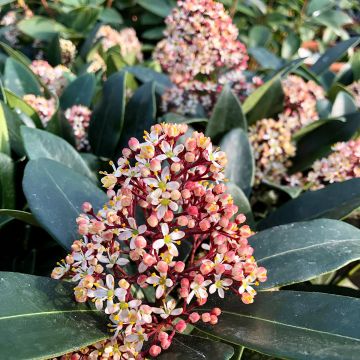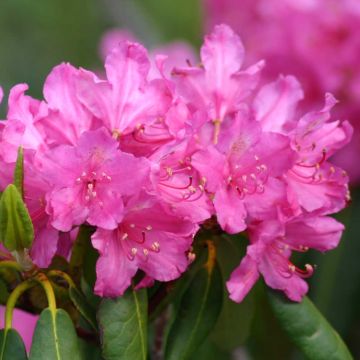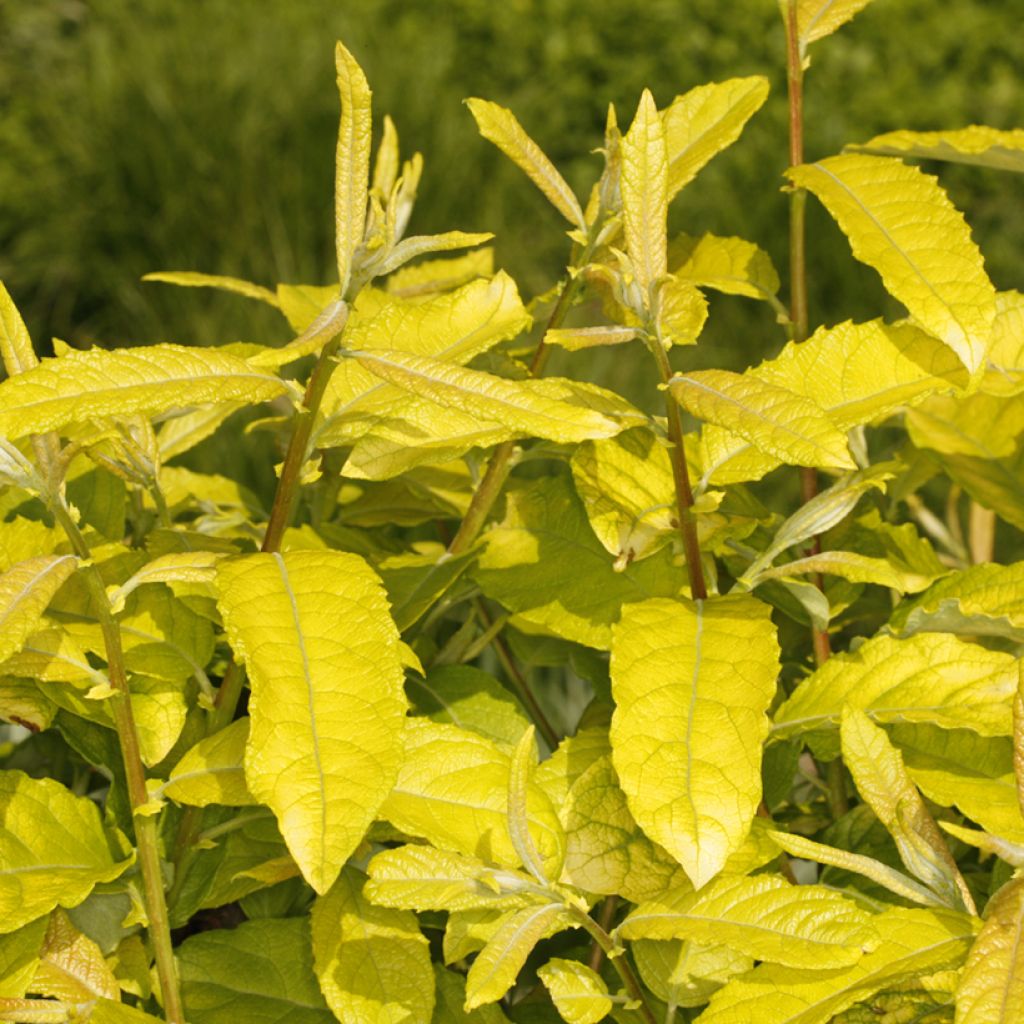

Salix caprea Ogon - Goat Willow
Salix caprea Ogon - Goat Willow
Salix caprea Ogon
Goat Willow, Pussy Willow
This item cannot be shipped to the selected country
Delivery charge from €5.90
Delivery to Corse prohibited
More information
Schedule delivery date,
and select date in basket
This plant carries a 24 months recovery warranty
More information
We guarantee the quality of our plants for a full growing cycle, and will replace at our expense any plant that fails to recover under normal climatic and planting conditions.
From €5.90 for pickup delivery and €6.90 for home delivery
Express home delivery from €8.90.
Delivery to Corse prohibited: UE law prohibits the import of this plant from mainland France to Corse as part of the fight against Xylella fastidiosa. Please accept our sincere apologies.
More information
Does this plant fit my garden?
Set up your Plantfit profile →
Description
Salix caprea 'Ogon' is a variety of goat willow selected for its very beautiful spring foliage in yellow tones. A beautifully changing foliage, which attracts attention from spring to autumn. Its small development, beauty, and accommodating character regarding the soil also suit a beginner gardener with a modest-sized garden.
Salix caprea 'Ogon' is a horticultural selection. The species is commonly referred to as goat willow, willow of the goats, marsault, or grey osier. It belongs to the Salicaceae family. This is a deciduous tree native to Europe, especially central Europe, and to central and northern Asia. The goat willow is a pioneering and ubiquitous species, an essential plant less exclusively linked to wet places than most other species of the genus Salix.
The 'Ogon' willow generally forms a bush with a neat habit, but it can also be trained as a miniature tree with multiple trunks. Young subjects show rapid growth. Subsequently, growth slows down and the plant does not exceed 5 m in height. The older branches are olive green, quite thin and long, forming an airy, slightly irregular dome-shaped crown, with a spread of approximately 3 m. The young branches are reddish-brown and slightly hairy. Flowering occurs in late winter (March) or very early spring (early April), on the bare branches. The flowers are grouped in catkins, providing pollen and nectar to the first foraging insects. Just after flowering, young leaves that also decorative develop. They emerge pink, then take on a bright lemon-yellow hue. This yellow colouration lasts for 2 months. In summer, the foliage displays a bright light green colour. The leaves are smooth and soft to the touch. They are broadly elliptical, measuring 5 to 10 cm long, slightly wavy and somewhat wrinkled at the edge. In autumn, the foliage turns yellow again before falling.
Salix caprea 'Ogon' withstands very cold winters perfectly and is very easy to cultivate in most regions. Unlike most willows, it does not require moist or waterlogged soil throughout the year and is capable of withstanding moderate drought periods with good episodic watering. Prune it every year after flowering to encourage it to thicken and produce numerous floriferous branches. It should be placed as a specimen, surrounded by early flowering bulbs (snowdrops, spring crocus, fritillaries, hyacinths), in a free-standing hedge or at the back of a flowerbed with coppice shoots. It will be perfect in a naturally inspired garden with white dogwoods, for example. Consider composing bouquets with its branches adorned with silver catkins. In a vase, they beautifully accompany those of Prunus triloba, flowering cherries, and plums that the warmth of the house will open.
Properties:
Like all willows, this species contains a substance in its bark similar to aspirin. It is highly nectar-rich and honey-producing: the bees that forage on it produce honey of golden yellow colour, iridescent green, which takes on amber to beige reflections as it ages. Its flavour is sweet, floral and slightly woody. Its foliage was once used as fodder for goats.
Report an error about the product description
Plant habit
Flowering
Foliage
Botanical data
Salix
caprea
Ogon
Salicaceae
Goat Willow, Pussy Willow
Cultivar or hybrid
Other Willow - Salix
Planting and care
Plant the Goat Willow 'Ogon' in non-scorching sunlight, sheltered from strong winds that could uproot this young plant with its poorly developed root system. Place a sturdy stake that you can remove after 2 or 3 years of cultivation. It is not very demanding regarding soil as long as it has some depth to allow the bush to find a bit of moisture in case of drought. In warm regions, once the young plant is established, a generous watering every 15 days or 3 weeks will be more than sufficient. It will adapt well to light, stony, and sandy soil as well as heavy, clayey, very wet soil. A small amount of lime is not a problem. Ideally, at planting, use a mixture composed of half potting compost and half garden soil. It is perfectly resistant to cold and severe frosts. To encourage a bushy habit and the formation of branches bearing catkins, prune fairly short (5 cm) after flowering, every year. Protect all cut wounds with a healing paste.
Planting period
Intended location
Care
This item has not been reviewed yet - be the first to leave a review about it.
Spring-flowering shrubs
Haven't found what you were looking for?
Hardiness is the lowest winter temperature a plant can endure without suffering serious damage or even dying. However, hardiness is affected by location (a sheltered area, such as a patio), protection (winter cover) and soil type (hardiness is improved by well-drained soil).

Photo Sharing Terms & Conditions
In order to encourage gardeners to interact and share their experiences, Promesse de fleurs offers various media enabling content to be uploaded onto its Site - in particular via the ‘Photo sharing’ module.
The User agrees to refrain from:
- Posting any content that is illegal, prejudicial, insulting, racist, inciteful to hatred, revisionist, contrary to public decency, that infringes on privacy or on the privacy rights of third parties, in particular the publicity rights of persons and goods, intellectual property rights, or the right to privacy.
- Submitting content on behalf of a third party;
- Impersonate the identity of a third party and/or publish any personal information about a third party;
In general, the User undertakes to refrain from any unethical behaviour.
All Content (in particular text, comments, files, images, photos, videos, creative works, etc.), which may be subject to property or intellectual property rights, image or other private rights, shall remain the property of the User, subject to the limited rights granted by the terms of the licence granted by Promesse de fleurs as stated below. Users are at liberty to publish or not to publish such Content on the Site, notably via the ‘Photo Sharing’ facility, and accept that this Content shall be made public and freely accessible, notably on the Internet.
Users further acknowledge, undertake to have ,and guarantee that they hold all necessary rights and permissions to publish such material on the Site, in particular with regard to the legislation in force pertaining to any privacy, property, intellectual property, image, or contractual rights, or rights of any other nature. By publishing such Content on the Site, Users acknowledge accepting full liability as publishers of the Content within the meaning of the law, and grant Promesse de fleurs, free of charge, an inclusive, worldwide licence for the said Content for the entire duration of its publication, including all reproduction, representation, up/downloading, displaying, performing, transmission, and storage rights.
Users also grant permission for their name to be linked to the Content and accept that this link may not always be made available.
By engaging in posting material, Users consent to their Content becoming automatically accessible on the Internet, in particular on other sites and/or blogs and/or web pages of the Promesse de fleurs site, including in particular social pages and the Promesse de fleurs catalogue.
Users may secure the removal of entrusted content free of charge by issuing a simple request via our contact form.
The flowering period indicated on our website applies to countries and regions located in USDA zone 8 (France, the United Kingdom, Ireland, the Netherlands, etc.)
It will vary according to where you live:
- In zones 9 to 10 (Italy, Spain, Greece, etc.), flowering will occur about 2 to 4 weeks earlier.
- In zones 6 to 7 (Germany, Poland, Slovenia, and lower mountainous regions), flowering will be delayed by 2 to 3 weeks.
- In zone 5 (Central Europe, Scandinavia), blooming will be delayed by 3 to 5 weeks.
In temperate climates, pruning of spring-flowering shrubs (forsythia, spireas, etc.) should be done just after flowering.
Pruning of summer-flowering shrubs (Indian Lilac, Perovskia, etc.) can be done in winter or spring.
In cold regions as well as with frost-sensitive plants, avoid pruning too early when severe frosts may still occur.
The planting period indicated on our website applies to countries and regions located in USDA zone 8 (France, United Kingdom, Ireland, Netherlands).
It will vary according to where you live:
- In Mediterranean zones (Marseille, Madrid, Milan, etc.), autumn and winter are the best planting periods.
- In continental zones (Strasbourg, Munich, Vienna, etc.), delay planting by 2 to 3 weeks in spring and bring it forward by 2 to 4 weeks in autumn.
- In mountainous regions (the Alps, Pyrenees, Carpathians, etc.), it is best to plant in late spring (May-June) or late summer (August-September).
The harvesting period indicated on our website applies to countries and regions in USDA zone 8 (France, England, Ireland, the Netherlands).
In colder areas (Scandinavia, Poland, Austria...) fruit and vegetable harvests are likely to be delayed by 3-4 weeks.
In warmer areas (Italy, Spain, Greece, etc.), harvesting will probably take place earlier, depending on weather conditions.
The sowing periods indicated on our website apply to countries and regions within USDA Zone 8 (France, UK, Ireland, Netherlands).
In colder areas (Scandinavia, Poland, Austria...), delay any outdoor sowing by 3-4 weeks, or sow under glass.
In warmer climes (Italy, Spain, Greece, etc.), bring outdoor sowing forward by a few weeks.


































